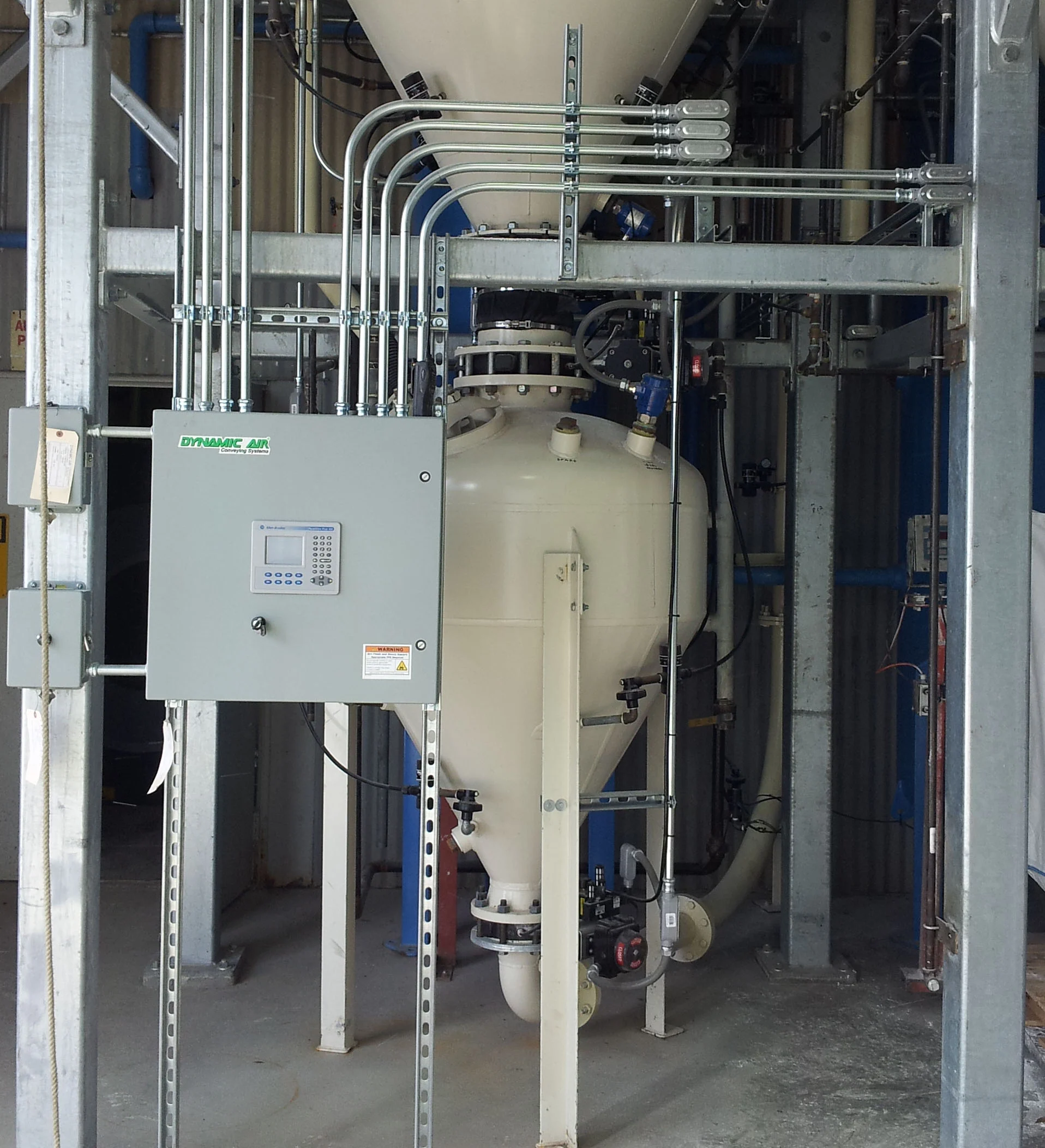Why Electronic Controlled Pressure Makes Sense in Dense Phase Pneumatic Conveying

In today’s competitive processing environment, efficiency, precision, and reliability are critical when handling dry bulk materials. Yet, many facilities still rely on outdated, one-size-fits-all pressure strategies for their pneumatic conveying systems.
At Dynamic Air, we’ve seen how this can hinder performance, increase maintenance needs, and degrade product quality—especially in dense phase conveying systems where material behavior can vary significantly.
That’s why electronic pressure control is transforming how industries manage their pneumatic conveying systems, offering unmatched optimization, consistency, and control.
The Problem with a “One Pressure Fits All” Approach
Traditionally, dense phase pneumatic conveying systems use a manual pressure regulator set to a fixed pressure. While simple, this approach forces operators to compromise. Instead of tuning the system for the specific material, convey distance, or system route, they set a mid-range pressure and hope it works well enough across all scenarios.
But “well enough” isn’t good enough anymore, especially when conveying conditions differ significantly.
Let’s look at the variables that impact ideal convey pressure:
1. Material Characteristics
Different materials behave differently under pressure. Take silica sand versus precipitated silica: silica sand is dense and requires higher convey pressures, while precipitated silica is light and fluffy and requires lower convey pressures. Applying the same pressure to both could either stall the heavier silica sand or cause product damage and excessive wear to the much lighter precipitated silica.
2. Convey Distance
The further you’re conveying material, the higher the pressure needed to keep it moving. A system designed for short transfers may underperform or fail entirely when tasked with longer runs unless the system dynamically adjusts the convey pressure for distance.
3. Process Requirements
In industries like food or chemical processing, product integrity is everything. For example, granulated sugar used in dry food products must maintain its shape, while sugar used in beverages can tolerate more degradation. Applying the wrong pressure can impact quality, compliance, and customer satisfaction.
4. Convey Pipe Route
Elevation rises and additional pipe bends add resistance, requiring more pressure to maintain the desired flow rate. A system with many turns and elevation changes can’t be treated the same as a straight, horizontal line.
Clearly, there’s no universal setting that works across all variables.
Enter Smart Conveying: The Case for Electronic Pressure Control
So what’s the solution? Instead of compromising with one static pressure, what if you could automatically adjust to the perfect pressure for each unique conveying scenario?
That’s exactly what electronic pressure regulators for bulk materials make possible.
By incorporating electronic pressure control into your dense phase pneumatic conveying system, you can program and maintain the optimal pressure for any material, distance, route, or process—without relying on manual intervention.
When Is Electronic Pressure Control Most Beneficial?
Below are three scenarios where the benefits of electronic pressure control in pneumatic conveying systems are especially valuable:
1. Multiple Conveying Destinations
If your system transfers material to multiple locations—each with a different distance, elevation, or pipe layout—your ideal conveying pressure isn’t just a little different between locations, it’s often drastically different. With electronic pressure regulators, the system can automatically apply the correct pressure for each destination, improving reliability and throughput.
2. Multiple Materials or Grades
Different materials (or even different grades of the same material) demand different handling. A single convey pressure for all materials just doesn’t cut it.. An electronic control system can store optimal settings for each material, conveying at the optimum pressure every time.
3. Improved System Management and Reliability
Electronic pressure control isn’t just about the performance, it’s about the management.
When you have visibility and management over system pressures through a digital interface, you gain better consistency, reduce downtime, and increase overall operational reliability. You can also track performance trends and proactively identify issues before they lead to failures.
Consequences of Sticking with Manual Pressure Regulators
Companies that stick to manual pressure systems often accept significant drawbacks including:
- Reduced conveying rate due to suboptimal pressure
- Increased product degradation, especially with fragile materials
- Excessive wear on pipes and components
- Inconsistent system performance and increased troubleshooting
- Higher labor costs due to manual adjustment needs
Ultimately, the cost of inefficiency outweighs the perceived simplicity of manual control.
How Dynamic Air Supports Smart Conveying
We understand that no two processes are alike—which is why we advocate for systems that adapt intelligently to your needs.
Our solutions featuring electronic pressure control are built to handle complex, multi-variable conditions—delivering greater efficiency, reduced maintenance, and better product quality. Whether you’re conveying powders, pellets, or granules, we’ll help you build a system that adapts in real time to your unique challenges.
Get Smarter with Your Conveying System
Today’s dense phase pneumatic conveying systems must be smarter, faster, and more adaptable than ever. Static systems using manual regulators simply can’t keep up with the complexity of modern operations.
Electronic pressure regulators for bulk materials give you the flexibility to handle a variety of materials and destinations—automatically, reliably, and without any guesswork. With electronic pressure control, you gain performance, reliability, and efficiency that manual systems just can’t match.
Ready to take your conveying system to the next level? Browse our systems and Contact Dynamic Air to learn how we can help you implement intelligent pressure control and maximize your system’s potential.
Let’s Find the Right Solution for You
Contact usPartner with Dynamic Air, the industry leader in providing reliable, innovative solutions. Our team of experts is ready to understand your unique requirements and design customized solutions tailored to your specific needs, whether it’s pneumatic conveying, equipment manufacturing, or other material handling challenges. Experience the Dynamic Air difference and unlock the potential of seamless material flow, enhanced efficiency, and optimized productivity. Contact us today to discuss your project.
